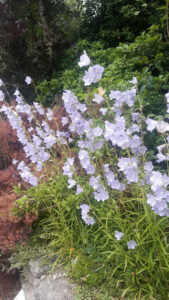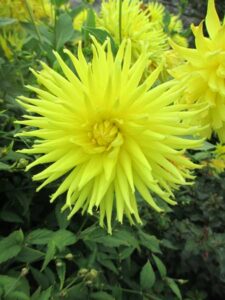Gardening
with Charlie Wilkins
RAVISHING PAINT COLOURS
Various redevelopments around the garden at ‘Villa Marie’ during my enforced Covid cocooning meant that paint brushes, hoes, and power tools were constantly in use! Garden chairs and tables were subjected to ‘musical chairs’, repositioned every other day, and colour changed on more than one occasion.
The actual job of choosing the colours was the best bit! What shade would complement the surroundings and lift the border residents? Which paint should be used, water or oil based?
I recalled how years ago I met a keen gardening friend who opened her ravishing Galway garden for charity on a very regular basis. She detested white garden furniture likening it to so many ‘aspirins’ usually plonked near choice perennials or on quality lawns. She had just painted her most comfortable seat a cool grey and it looked delightful. Pale greens and blues were used on other sets especially those sited in sheltered, hidden areas which one had to stumble upon rather than notice from a distance. They looked so wonderful that I have followed her colour schemes ever since and delight whenever new ‘garden shades’ are introduced by paint-makers.
You can buy pastel-like colours from fancy (and expensive) paint-makers or you can be canny and spot the same thing in your local hardware shop. Many can be found in the larger hardware stores under the brand name ‘Cuprinol Garden Shades’. One of the really nice things about these water-based paints is that you can change your mind (and outdoors furniture) every year-or more often if you like! Another plus is the brushes and your hands can be cleaned with water.
Every year I note how the top garden designers (who photograph the winning gardens at the Chelsea Flower Show) use similar shades of paint on all their timber garden features: gazebos, furniture, decking, sheds, even summerhouses.
At home, you do not have to stop there! One of the best paint effects I have ever indulged in is now quite ‘invisible’. Years ago, I invested in a bundle of galvanised wire hoops to support the floppy growth of herbaceous plants, especially dahlias and delphiniums. The instructions promised that that once in place they would be hidden in a week, but some galvanised extrusions always seemed to be sticking up in front of the phloxes and lupins, lobelia, and tall campanulas. So, in desperation I bought a tin of unconventional green, sprayed the lot, and I haven’t seen them since!
Last summer, following a disastrously cold spring (in which terra-cotta pots fractured and shattered) I took stock of the undamaged remains and began a programme of renewal. From the illustration you can see how one large old pot was transformed from something chalky and neglected into a desirable feature. It survives to this day and may this month of September receive yet another change of colour.

THE GARDEN IN SEPTEMBER
TIMELY TIP
Lavender will become gnarled and woody if left un-pruned. Early September is the ideal time to take the shears to these, even if they are still showing a few pathetic flower spikes. Remove all the flower heads, their stalks, and a couple of inches of spiky foliage aiming for a bush of rounded shape. With old lavender this may not be possible so best to replace these.
CYCLAMEN QUANDARY
When you go to plant autumn cyclamen (on sale now as dry corms) you may become perplexed how they are planted for they develop roots from the tops of their corms not the bottom! How then do you distinguish top and bottom? Look for the bottom first for it will be seen to have a hollowed out concave pattern. Even then, it may not be obvious. Because they enlarge year after year (eventually growing to dinner-plate size) their top surface eventually becomes disfigured, wisen and with cracks and dents. These marks signify the top, even on small corms. Now you have two indicators as to which is top and bottom.
WEATHER
It is not in the Irish character to view the element of water with veneration and awe. There has always been so much of it around, surging in fulsome rivers or falling from leaden skies. Last week it came bucketing down coupled to ferocious winds, putting an untimely end to hybrid roses, ostentatious agapanthus, and extravagant begonias! Perhaps these will rally again, perhaps not. This is one of the many ticklish questions that beset all gardeners during their gardening life.
If contemplating new shrubs this autumn, do consider azaleas. I have never met a gardener, male or female, who was disappointed with azaleas. Of course, if you love them and have the right kind of lime-free soil, the scope is joyous. But if your soil is alkaline you can still grow them in suitable tubs and containers or in specially dug and prepared planting holes (separated from the surrounding soil by a vertical lining to the sides of the hole with polythene) in any half-shaded spot. Fill this hole with a lime-free medium; leaf-mould, pine-needles, garden compost or used potting compost. All will be found ideal for azaleas.for flower arranging.







